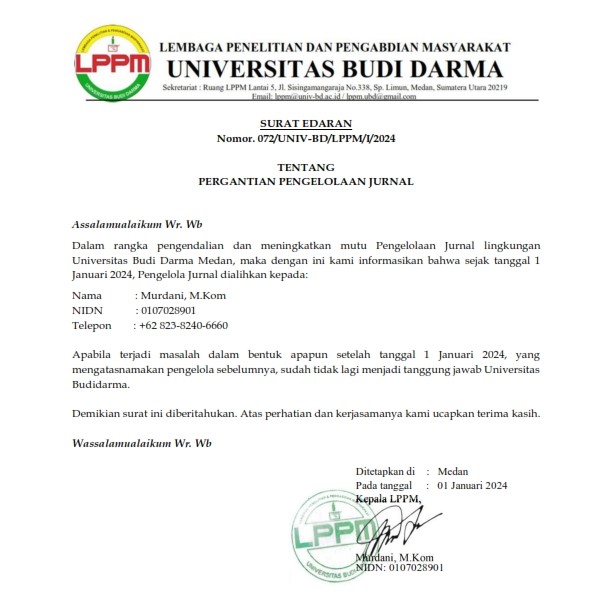Pemanfaatan Algoritma Hebb Rule Mendiagnosis Kerusakan Elektroda Pada Proses Welding Frame Thermostat
DOI:
https://doi.org/10.30865/jurikom.v9i6.5335Keywords:
Artificial Intelligence, Artificial Neural Networks, Electrodes in the Thermostat Frame Welding Process on SoulplateAbstract
In the current era of technological development, developments in computer systems are very fast, computerized systems are needed at this time, including to diagnose electrodes in the welding process, frame thermostats on soulplate, because sometimes it's mechanical. Mechanics find it difficult to detect damage to machines due to the absence of a good computerized system. The use of SMAW (Shielded Metal Arc Welding) in the industrial world is quite widely used. With this machine humans are greatly helped by the need to make a metal object. So that with the frequent use of these tools, it will also be more vulnerable to damage to these tools. The machine technicians supplied by the company are not proportional to the number of machines. Therefore, to help solve the problem. The purpose of this research is to make it easier for mechanics to detect engine damage. This study uses the Hebb Rule method with the simplest learning method concept. In this method learning is done by fixing the weight values in such a way that if there are 2 connected neurons, and both are 'on' at the same time, then the weight between the two is increased. If the data is represented in a bipolar manner, then the weight is improved. Therefore this method is very useful in solving a problem that occurs. The final result of this research is 1, in which the network can understand the intended pattern. It has a value of 1 because it uses a binary number pattern, not bipolar.
References
S. N. Riski, “Sistem Pakar Untuk Mendeteksi Kesalahan Elektroda Pada Proses Welding Frame Thermostat Pada Soulplate Menggunakan Metode Forward Chaining Berbasis Web (Studi Kasus Pt Philips),†Edik Informatika, vol. 3, no. 2, pp. 211–225, 2017, doi: 10.22202/ei.2017.v3i2.2248.
M. U. Musthofa, Z. K. Umma, and A. N. Handayani, “Analisis Jaringan Saraf Tiruan Model Perceptron Pada Pengenalan Pola Pulau di Indonesia,†Jurnal Ilmiah Teknologi Informasi Asia, vol. 11, no. 1, p. 89, 2017, doi: 10.32815/jitika.v11i1.56.
R. Husen et al., “Pengenalan Pola Sidik Jari Berbasis Jaringan Saraf Tiruan Perambatan Balik,†Pengenalan Pola Sidik Jari Berbasis Jaringan Saraf Tiruan Perambatan Balik, vol. 1, no. 1, pp. 1–20, 2015.
Sumijan, A. P. Windarto, A. Muhammad, and Budiharjo, “Implementation of neural networks in predicting the understanding level of students subject,†International Journal of Software Engineering and its Applications, vol. 10, no. 10, pp. 189–204, 2016, doi: 10.14257/ijseia.2016.10.10.18.
N. Feri Rahmadani, Akim M.H. Pardede, “Jaringan Saraf Tiruan Prediksi Jumlah Pengiriman Barang Menggunakan Metode Backpropagation ( Studi Kasus : Kantor Pos Binjai ),†Jtik (Jurnal Teknik Informatika Kaputama), vol. 5, no. 1, pp. 100–106, 2021.
Z. Arifin, “Jaringan Saraf Tiruan Bidirectional Associative Memory (BAM) Sebagai Identifikasi Pola Sidik jari Manusia,†Jurnal Informatika Mulawarman Program Studi Ilmu Komputer Universitas Mulawarman, vol. 4, no. 1, pp. 21–26, 2009.
D. Avianto, “Pengenalan Pola Karakter Plat Nomor Kendaraan Menggunakan Algoritma Momentum Backpropagation Neural Network,†Jurnal Informatika, vol. 10, no. 1, pp. 1199–1209, 2016, doi: 10.26555/jifo.v10i1.a3352.
M. Fadhilla, M. R. A. Saf, and D. S. S. Sahid, “Pengenalan Kepribadian Seseorang Berdasarkan Pola Tulisan Tangan Menggunakan Jaringan Saraf Tiruan,†Jurnal Nasional Teknik Elektro dan Teknologi Informasi (JNTETI), vol. 6, no. 3, 2017, doi: 10.22146/jnteti.v6i3.340.
A. Sudarsono, “Jaringan Saraf Tiruan Untuk Memprediksi Laju Pertumbuhan Penduduk Menggunakan Metode Bacpropagation (Studi Kasus Di Kota Bengkulu),†Jurnal Media Infotama, vol. 12, no. 1, pp. 61–69, 2016, doi: 10.37676/jmi.v12i1.273.
A. Fadlil, I. Riadi, and A. Nugrahantoro, “Kombinasi Sinkronisasi Jaringan Saraf Tiruan dan Vigenere Cipher untuk Optimasi Keamanan Informasi,†Digital Zone: Jurnal Teknologi Informasi dan Komunikasi, vol. 11, no. 1, pp. 81–95, 2020, doi: 10.31849/digitalzone.v11i1.3945.
Ansori, “Pengenalan Pola Dua Dimensi Sederhana Dengan Jaringan Saraf Tiruan Hebb,†Paper Knowledge . Toward a Media History of Documents, vol. 3, no. April, pp. 49–58, 2015.
S. Purba, “Pengenalan Karakter Menggunakan Metode Bidirectional Associative Memory ( Bam ) Kontinu,†vol. 11, no. 01, pp. 89–101, 2019.
T. Mulyana, “Segmentasi Citra Menggunakan Hebb-Rule Dengan Input Variasi Rgb,†Jurnal Teknologi Informasi, vol. Vol. 1, no. No. 1, pp. 30–39, 2015.
F. Yanti and J. Sutrisna, “Perbandingan Saham Hang Seng dan Nikkei Menggunakan Algoritma Hebbian,†Jurnal Informatika Universitas Pamulang, vol. 2, no. 1, p. 7, 2017, doi: 10.32493/informatika.v2i1.1499.
E. D. Manurung, B. Nadeak, and E. Ndruru, “Implementasi Algoritma Hebb Rule Pada Diagnosa Penyakit Kolik Abdomen Pada Orang Dewasa,†JURIKOM (Jurnal Riset Komputer), vol. 7, no. 2, p. 250, 2020, doi: 10.30865/jurikom.v7i2.2086.
G. A. Pauzi, “Sistem Identifikasi dan Pengenalan Pola Citra Tanda-Tangan Menggunakan Sistem Jaringan Saraf Tiruan ( Artificial Neural Networks ) Dengan Metode Backpropagation,†vol. 03, no. 02, pp. 93–101, 2015.
D. Muliona Rizki, “Jaringan Saraf Tiruan Pengenalan Pola Huruf,†vol. 2, no. 1, pp. 46–50, 2018.
M. Nasir, Amri, and I. Maulina, “Pengenalan Aksara Isyarat Menggunakan Metode Hebb Rule,†Jurnal Infomedia, vol. 4, no. 1, pp. 28–32, 2019.








